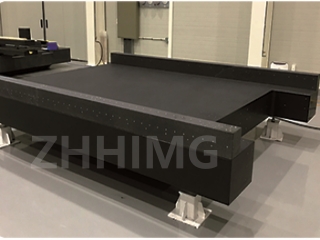Granite is a commonly used material in the fabrication of components used in semiconductor devices. These pieces, typically in the form of chucks and pedestals, provide a stable platform for moving and positioning semiconductor wafers during various stages of the manufacturing process. The performance and reliability of these granite components are influenced by a variety of factors, including the environment in which they are used.
One of the most important environmental factors that affect granite components in semiconductor devices is temperature. Granite has a relatively low coefficient of thermal expansion, which means that it can withstand a wide range of temperatures without warping or cracking. However, extreme temperature fluctuations can cause stress within the material, leading to cracking or delamination of the surface. In addition, exposure to high temperatures for prolonged periods can cause the material to soften, making it susceptible to deformation and wear.
Humidity is another important environmental factor that impacts the performance of granite components in semiconductor devices. High humidity levels can cause moisture to seep into the porous surface of the granite, leading to delamination or cracking. Additionally, moisture can cause electrical shorts, which can damage delicate electronic components that are being processed on the granite surface. To prevent these issues, it is important to maintain a dry environment during semiconductor manufacturing processes.
Chemical exposure is also an important consideration when using granite components in semiconductor devices. Granite is generally resistant to most chemicals, but certain solvents and acids can cause damage to its surface. Common cleaning agents such as isopropyl alcohol or hydrofluoric acid can etch or corrode the granite surface, leading to surface roughness and decreased flatness. To avoid these issues, care should be taken when selecting cleaning agents and procedures to prevent chemical damage.
Another environmental factor that affects the performance of granite components is vibration. Vibrations can cause microcracks in the granite surface, leading to degradation of the surface flatness. To mitigate vibration, it is essential to take appropriate steps such as installing vibration isolation systems and avoiding unnecessary movement of the granite components.
In conclusion, the performance of granite components in semiconductor devices is influenced by a variety of environmental factors including temperature, humidity, chemical exposure, and vibration. By taking appropriate measures to minimize exposure to these factors, manufacturers can ensure the reliability and longevity of granite components in semiconductor devices. With careful attention to environmental factors and proper maintenance, granite components will continue to play a vital role in the semiconductor industry.
Post time: Apr-08-2024

